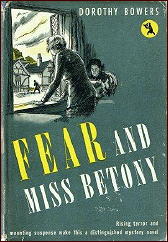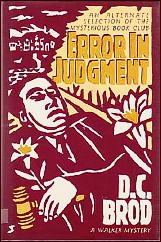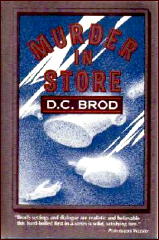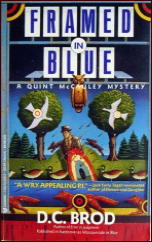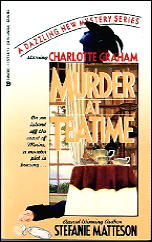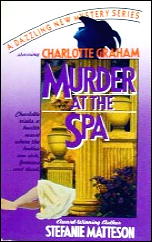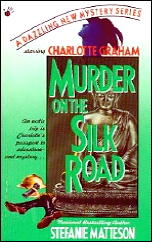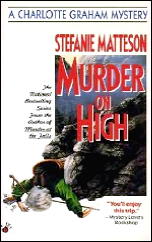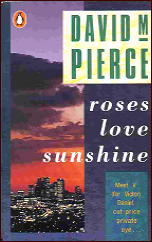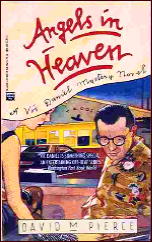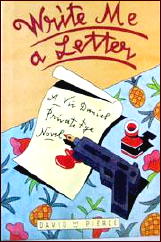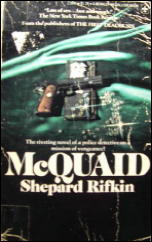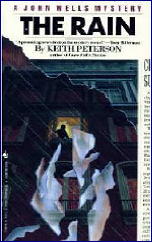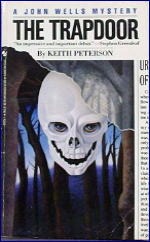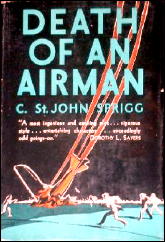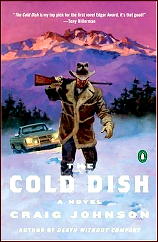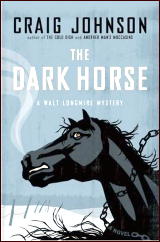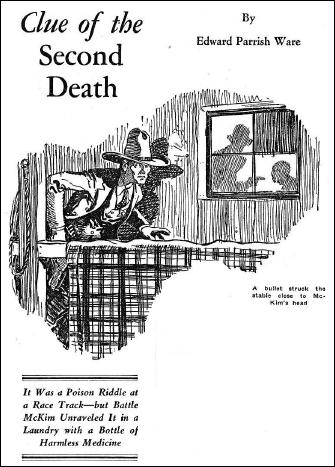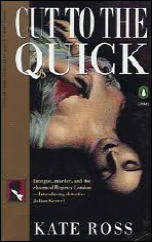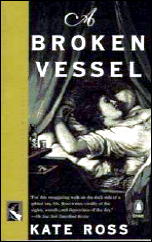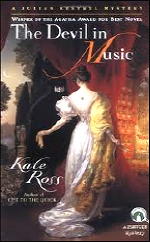THE SERIES CHARACTERS FROM
DETECTIVE FICTION WEEKLY
by MONTE HERRIDGE
#6. BATTLE McKIM, by Edward Parrish Ware.
The Battle McKim stories by Edward Parrish Ware were a short series of at least thirteen tales published in Detective Fiction Weekly between 1934 through 1937. The stories are about a detective who works for Sheriff Calloway in Zinc City, near the Ozark Mountains in what appears to be Missouri.
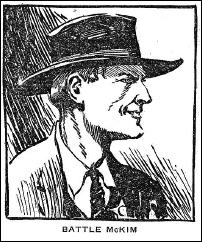
Zinc City has a population of something over fifty thousand residents. “Brutus McKim, nicknamed ‘Battle,’ . . . stood five feet and five inches in his low-heeled shoes, and weighed one hundred and thirty pounds. His age was somewhat under forty, and his nature was as mild as milk. But this small, mild-mannered man had, on more than one occasion, proved his right to the nickname which had been bestowed on him originally in fun.†(The Clue of the Broken Chimney)
In fact, in the first story McKim has to shoot two criminals who tried to kill him. However, Battle McKim “hated to use his gun. It was against his nature to kill. When he just had to do it, he did.†In one story, it was revealed that McKim was especially fond of circuses and circus people, and thought that circus bands “made the finest music of any other bands whatever.†(Clue of the Elephant’s Ear) McKim is never without his Stetson hat nor his gun.
The stories mostly have titles that involve a clue which is important to the solution of the story. Ware had other series which were published in DFW: the Ranger Jack Calhoun series (1926-1938), Tug Norton (1926-1934), and Buck Harris (1930-1934). So Ware wrote many stories for the magazine, but nothing after 1938.
The first known story in the Battle McKim series is “The Clue of the Broken Chimney†which sets forth some background facts and in its plot shows what the series was going to be like. McKim sees in the death of a mining owner by a fall from a height to be murder, when everyone else disagrees and claims either accident or suicide.
McKim’s investigation into the matter causes some trouble for him with criminals, but he is not deterred. The sheriff seems to have great confidence in McKim’s abilities and will go along with whatever he says.
“Clue of the Bandit’s Beard†involves the false beard one of the criminals wears. The story involves the holdup and murder at a mining encampment. In this story Battle McKim shows his sleuthing and tracking abilities by tracking down the criminals.
As seems to be usual in this series, he has gunfights with the criminals. However, he takes such a long time tracking down the criminals that Sheriff Calloway becomes angry at his absence. It seems that the sheriff depends a bit too much upon his resident detective.
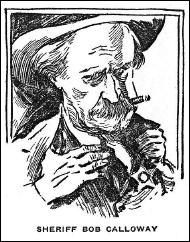
“The Clue of the Animal Crackers†actually involves the contents of a box of animal crackers. These crackers seem to have been around a long time; I assume they are still available nowadays. The scene is the county fair, where a carnival is taking place. One of the carnival people has been murdered, and McKim must figure out who committed the crime. The animal crackers play a significant role in the solution of the mystery. For a change, there is no gunfight between McKim and the criminal.
“Clue of the Battered Bullets†involves a mysterious case of murder and a kidnapping of a banker. Upon investigation, Battle McKim also finds plenty of clues leading in various directions. He suspects that there is more to the case than first appears, and by the end, he has to gunfight with a criminal who was behind it all. A number of the stories in this series involve gunfights with the criminals. Occasionally McKim does capture the criminals alive.
“Clue of the Elephant’s Ear†takes place at the Moseby’s Marvelous Circus, which is visiting Zinc City. The headliner of the circus and its greatest attraction is the intelligent elephant Bong the Great, or Bong, the Elephant with the Human Brain as he is billed on advertisements. Battle McKim investigates after the elephant kills its trainer during a performance.

The killing by the elephant was due to a sudden rage that came over the elephant, and McKim wants to know if there are reasons for this behavior. Sheriff Calloway objects to this, saying that he has already decided to kill the elephant as a dangerous beast. McKim doesn’t pay any attention to this and investigates anyway.
“Clue of the Persian Cat†involves two Persian cats and a murder mystery at a roadhouse. One of the two owners has been mysteriously killed, and the first thing Battle McKim must decide is whether it was suicide or murder. There aren’t very many suspects, so the mystery angle is a bit slim. The cats’ involvement turns out to be important in the mystery, and leads McKim to the solution.
“Clue of the Poisoned Dog†presents Battle McKim with a murder mystery that has taken place at a rich man house where several people are guests. It also takes place in the midst of a snowstorm, which shows that no on entered or left the house at the time of the murder. In addition, unset diamonds valued at a hundred thousand dollars have been stolen from the dead man. McKim cleverly solves the crimes and recovers the diamonds.
“Clue of the Hard-Boiled Eggs†has a slim clue for Battle McKim to work on. A local farmer had sold some land for $10,000 and decided to hide the money on his property rather than putting it in the bank. McKim becomes involved after the man supposedly died accidentally, leaving his money still hidden.
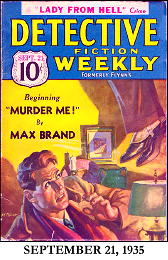
After investigating, McKim deduces that the farmer was actually murdered and his money stolen. McKim has to resort to trickery to force the criminal to give himself away as the guilty man.
“Clue of the Pekin Ducks†is another good story. The clue of the ducks involves their reputation as a night alarm, alerting their owner as to trespassers. The crime here is of the murder and robbery of their owner, a stingy, miserly, person who is disliked by virtually everyone. Plenty of suspects in a case of this nature. But the duck clue led Battle McKim to the only person who could have committed the crime.
“Clue of the Crawling Cows†deals with a different kind of crime. A train baggage car of the Missouri Central Railroad has been robbed, one of the car workers tied up and the other man missing as well as fifty thousand dollars gone.
Battle McKim must find out where the missing train worker went as well as find the missing money. The story is clever, and McKim finds the definitive clue in the behavior of some cattle next to the train tracks.
“Clue of the Second Death†involves a murder by somewhat improbable means, but the author seems to make it work in the story, although it is a bit far-fetched that Battle McKim should be able to figure it out. The murder victim is Colonel Shel Allen, who is stricken dead by aconite poisoning while driving his car.
Because Allen was the county prosecutor, suspicion comes down on a crooked judge and his friends, but McKim tends to believe in a different group of suspects and devotes his investigation to them. The second death clue gives McKim the evidence he needs to figure out who committed the first murder.
“Clue of the Tallow Candle†was the last story in the series, and much of it takes place underground in some caves near Zinc City. A noted judge has been killed in one of the caves, and Battle McKim must first prove it was deliberate murder rather than an accident.
As usual, hidden clues contribute to the story, and a second death makes the mystery more difficult to solve. However, McKim draws the suspects around with the addition of others in the sheriff’s department, and proves who committed the murder and why. As often happens, McKim shoots it out with the killer.
This is an average series, with very good stories. There is not any humor in the stories, just a basic storytelling technique that does a decent job of the adventures of Battle McKim in his quest for the truth.
The stories are at least a change from the sameness that had crept into Ware’s series about Ranger Jack Calhoun. Interestingly, Ware must have disliked veterinarians, as he makes them the villain in two of the stories.
The Battle McKim series by Edward Parrish Ware:
The Clue of the Broken Chimney October 27, 1934
Clue of the Bandit’s Beard November 10, 1934
The Clue of the Animal Crackers November 24, 1934
Clue of the Battered Bullets March 16, 1935
Clue of the Elephant’s Ear April 20, 1935
Clue of the Persian Cat May 4, 1935
Clue of the Poisoned Dog August 3, 1935
Clue of the Hard-Boiled Eggs August 10, 1935
Clue of the Pekin Ducks September 21, 1935
Clue of the Putty Paper November 2, 1935 *
Clue of the Crawling Cows December 21, 1935
Clue of the Second Death March 21, 1936
Clue of the Tallow Candle October 9, 1937
* I don’t have this story, but the title indicates it might be part of the series. [And so it is. See Comment #1.]
Previously in this series:
1. SHAMUS MAGUIRE, by Stanley Day.
2. HAPPY McGONIGLE, by Paul Allenby.
3. ARTY BEELE, by Ruth & Alexander Wilson.
4. COLIN HAIG, by H. Bedford-Jones.
5. SECRET AGENT GEORGE DEVRITE, by Tom Curry.
